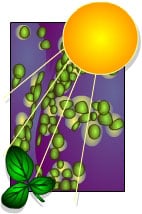Photosynthesis
Created | Updated Jul 25, 2013

Photosynthesis is the process in which sunlight is converted into usable energy by organisms, such as green plants. As almost all of the food on the planet originates from plants, this means that almost everything originates from the Sun1. Sunlight acts as food for plants. Fertiliser, although it provides essential nutrients, is often confused as 'plant food'. Plants take in carbon dioxide and 'excrete' oxygen while photosynthesis occurs2.
Where Photosynthesis Occurs
Photosynthesis takes place exclusively inside organelles. These are small organ-like structures found inside cells and they are known as chloroplasts. They are a type of plastid, as are mitochondria, and the two are very similar. Chloroplasts contain a coloured pigment known as chlorophyll, and this determines the colour of the plant. All chlorophyll is green, yet not all plants are green. This is due to the existence of other non-green photosynthetic pigments, like the xanthophylls, and so on.
There are two main parts to a chloroplast:
- Stroma
- Thylakoid membrane
The thylakoid membrane system is a series of membranes folded up into stacks called grana3. They are similar to a pile of records stacked on top of one another and joined to other stacks by more membranes. It is likely that the membranes are only one sac, which is highly folded. This structure is likely to be a result of needing a large surface area for the photosynthetic reaction.
How Photosynthesis Occurs
The chemical process of photosynthesis is very complicated, and is still not completely understood. The basic formula is:
6CO2 + 12H2O + Energy from the Sun ---> C6H12O6 + 6O2 + 6H2O.
Or: Carbon Dioxide + Water + Energy from the Sun ---> Glucose + Oxygen.
Photosynthesis takes place in two main steps - the light reaction and the dark reaction.
The Light Reaction
This process requires energy from the Sun to proceed, and as such, it is here that the energy of the Sun is captured. The light reaction occurs on and inside the thylakoid membrane.
Sunlight hits an integral-membrane protein - IMP - called photosystem II. This causes a molecule of water to be split up into hydrogen ions - H+ - and oxygen. A photosystem is a complicated name for a protein that is stuck through the membrane, then performs a chemical reaction when sunlight hits it. In this case it breaks water into its component atoms.
The hydrogen ions are released into the thylakoid space. The thylakoid space is almost identical to the inter-membrane space of a mitochondrion and the lumen of the endoplasmic reticulum. This is a result of their evolutionary origins. The electrons captured by this process are passed along an electron transport chain, identical to that found in mitochondria. These electrons power the IMP 'pumps', pushing more H+ ions into the thylakoid space.
The electrons end up at photosystem I4. Photosystem I receives light, and one of its electrons jumps off, converting NADP+ to NADPH. This creates an electron 'hole' which the incoming electron from photosystem II fills. NADP+ is an electron carrier. It grabs an electron and a hydrogen ion to become NADPH, then travels to where the electron is needed. The hydrogen ion falls off and it returns to NADP+.
There are many H+ ions within the thylakoid space compared to the outside. Thus, because of diffusion and their positive charge, they try to move to the region with the lowest concentration. However, to escape the thylakoid, they have to pass through an enzyme known as ATP synthase. This acts as a turnstile, and as H+ ions leave, they pass through this protein, and in doing so convert ADP to ATP5.
The Dark Reaction
The dark reaction consists of the Calvin cycle, which occurs in the stroma of the chloroplast. It involves a very complex series of chemical reactions in which 3 molecules of CO2, 9 molecules of ATP and 6 molecules of NADPH are converted into a carbohydrate molecule known as glyceraldehyde 3-phosphate. This is then converted into other sugars, such as glucose.
How Photosynthesis Started
Chloroplasts and mitochondria are both plastids. Plastids contain their own DNA and can thus self-replicate and synthesise their own proteins to some extent. Scientists believe this is due to them originating as free-living bacteria, which entered a cell and began a mutual, 'symbiotic', relationship. This is quite a likely suggestion as plastid DNA forms a loop, similar to bacteria, rather than a linear form. Also the ribosomes - the structure which synthesises protein - in plastids are most similar to bacteria, rather than the surrounding cellular ribosomes.

